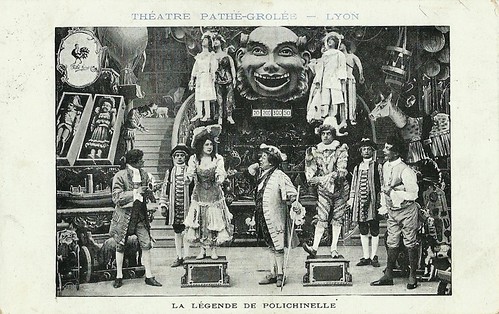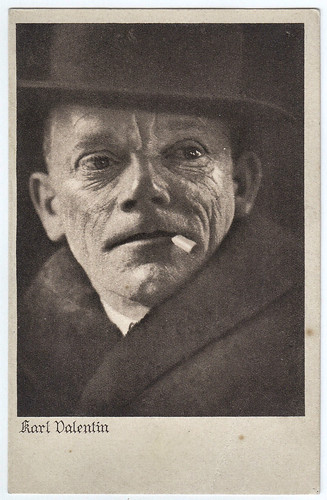Till Saturday 12 October EFSP follows Le Giornate del Cinema Muto. The Silent Film Festival in Pordenone is the main festival in its kind and this year's edition is the 38th. Yesterday we had a post on the early comedies with 'Nasty women', and today the men follow. The programme 'The Origins of European Slapstick' presents comedies with 'Euro-clowns' like Max Linder, Walter Forde, Grock, Karl Valentin, Charles Puffy and the Scandinavian duo Pat & Patachon (or Fi og By), amd EFSP presents their postcards.

French postcard by Théâtre Pathé Grolée, Lyon. Photo: Pathé Frères. Max Linder as Polichinelle in La légende de Polichinelle (Albert Capellani, 1907).
Polichinelle is an automaton in love with a cute doll in the same shop. When the doll is sold, a fairy helps Polichinelle to follow her. After a series of wild adventures he arrives at the house of the buyer just in time to save the doll from being burned.

French postcard. Photo: Pathé.
French comedian Max Linder (1883-1925), with his trademark silk hat, stick and moustache was an influential pioneer of the silent film. He was largely responsible for the creation of the classic style of silent slapstick comedy and he was the highest paid entertainer of his day.

French postcard by J. Combier, Macon. Photo: Production Jacques Haik. Grock in Son premier film (Jean Kemm, 1926).
Grock (1880-1959) was a Swiss clown, composer and musician. 'The king of clowns' was once the most highly paid entertainer in the world. His act was a mixture of pantomime and musical blunders. Some of Grock's performances have been preserved on film such as in the silent film Son premier film/What For? (Jean Kemm, 1926).

German postcard by Heliogravüre J.B. Obernetter, München. Collection: Marlene Pilaete.
Bavarian comedian Karl Valentin (1882-1948) starred in many silent German films in the 1920s. Valentin was also active as a cabaret performer, clown, author and film producer, and was sometimes called the 'Charlie Chaplin of Germany'. His work influenced artists like Bertolt Brecht and Samuel Beckett.

German postcard by Ross Verlag, no. 1207/1, 1927-1928. Photo: Roman Freulich / Unfilman (Universal).
Fat Hungarian stage and film comedian Károly Huszár (1884–1942 or 1943) or Charles (Huszar-)Puffy or Karl Huszar-Puffy was the most popular slapstick star of the Hungarian silent era. He later worked in both Germany and Hollywood. He played minor roles in such classics as Dr. Mabuse, der Spieler/Dr. Mabuse, King of Crime (1922) and he was the star of a series of slapstick shorts for Universal.

Italian postcard by Il Piùlibri. Photo: youth portrait of Antonio De Curtis (Totò) with dedication.
Totò (1898–1967) was one of the most popular Italian film stars ever, nicknamed 'il principe della risata' (the prince of laughter). He starred in about 100 films, many of which are still frequently broadcast on Italian television. Totò is an heir of the Commedia dell'Arte tradition, and can be compared to Buster Keaton and Charlie Chaplin. His style and some of his recurring jokes and gestures are universally known in Italy.

German postcard by Ross Verlag, no. 3828/2, 1928-1929. Photo: Lothar Stark-Film. Fy og Bi in Filmens Helte/Long and Short, the film heroes (Lau Lauritzen, 1928), produced by the Danish studio Palladium.
The Danish double-act Fy og Bi (Fyrtårnet og Bivognen aka Pat & Patachon or Long and Short) was the most famous comedy couple of the European silent cinema. Long Carl Schenstrom (1881-1942) and short Harald Madsen (1890-1949) became very popular in the 1920s with their short slapstick films.

Dutch postcard for the Danish comedians Fy og Bi, that is long Carl Schenstrom (1881-1942) and short Harald Madsen (1890-1949). They were called 'Watt & Half Watt' in the Netherlands (Long and Short in Britain, Pat und Patachon in Germany). The Dutch cinema De Munt, Kalverstraat 226, Amsterdam, was at the time the cinema for their films in Amsterdam.

French postcard by Théâtre Pathé Grolée, Lyon. Photo: Pathé Frères. Max Linder as Polichinelle in La légende de Polichinelle (Albert Capellani, 1907).
Polichinelle is an automaton in love with a cute doll in the same shop. When the doll is sold, a fairy helps Polichinelle to follow her. After a series of wild adventures he arrives at the house of the buyer just in time to save the doll from being burned.

French postcard. Photo: Pathé.
French comedian Max Linder (1883-1925), with his trademark silk hat, stick and moustache was an influential pioneer of the silent film. He was largely responsible for the creation of the classic style of silent slapstick comedy and he was the highest paid entertainer of his day.

French postcard by J. Combier, Macon. Photo: Production Jacques Haik. Grock in Son premier film (Jean Kemm, 1926).
Grock (1880-1959) was a Swiss clown, composer and musician. 'The king of clowns' was once the most highly paid entertainer in the world. His act was a mixture of pantomime and musical blunders. Some of Grock's performances have been preserved on film such as in the silent film Son premier film/What For? (Jean Kemm, 1926).

German postcard by Heliogravüre J.B. Obernetter, München. Collection: Marlene Pilaete.
Bavarian comedian Karl Valentin (1882-1948) starred in many silent German films in the 1920s. Valentin was also active as a cabaret performer, clown, author and film producer, and was sometimes called the 'Charlie Chaplin of Germany'. His work influenced artists like Bertolt Brecht and Samuel Beckett.

German postcard by Ross Verlag, no. 1207/1, 1927-1928. Photo: Roman Freulich / Unfilman (Universal).
Fat Hungarian stage and film comedian Károly Huszár (1884–1942 or 1943) or Charles (Huszar-)Puffy or Karl Huszar-Puffy was the most popular slapstick star of the Hungarian silent era. He later worked in both Germany and Hollywood. He played minor roles in such classics as Dr. Mabuse, der Spieler/Dr. Mabuse, King of Crime (1922) and he was the star of a series of slapstick shorts for Universal.

Italian postcard by Il Piùlibri. Photo: youth portrait of Antonio De Curtis (Totò) with dedication.
Totò (1898–1967) was one of the most popular Italian film stars ever, nicknamed 'il principe della risata' (the prince of laughter). He starred in about 100 films, many of which are still frequently broadcast on Italian television. Totò is an heir of the Commedia dell'Arte tradition, and can be compared to Buster Keaton and Charlie Chaplin. His style and some of his recurring jokes and gestures are universally known in Italy.

German postcard by Ross Verlag, no. 3828/2, 1928-1929. Photo: Lothar Stark-Film. Fy og Bi in Filmens Helte/Long and Short, the film heroes (Lau Lauritzen, 1928), produced by the Danish studio Palladium.
The Danish double-act Fy og Bi (Fyrtårnet og Bivognen aka Pat & Patachon or Long and Short) was the most famous comedy couple of the European silent cinema. Long Carl Schenstrom (1881-1942) and short Harald Madsen (1890-1949) became very popular in the 1920s with their short slapstick films.

Dutch postcard for the Danish comedians Fy og Bi, that is long Carl Schenstrom (1881-1942) and short Harald Madsen (1890-1949). They were called 'Watt & Half Watt' in the Netherlands (Long and Short in Britain, Pat und Patachon in Germany). The Dutch cinema De Munt, Kalverstraat 226, Amsterdam, was at the time the cinema for their films in Amsterdam.
No comments:
Post a Comment